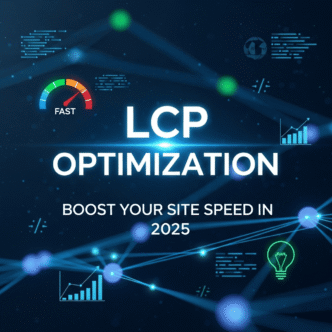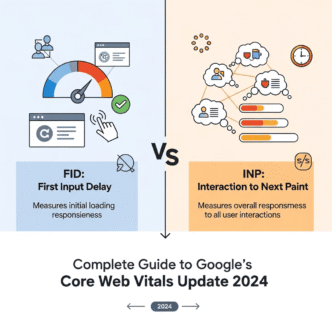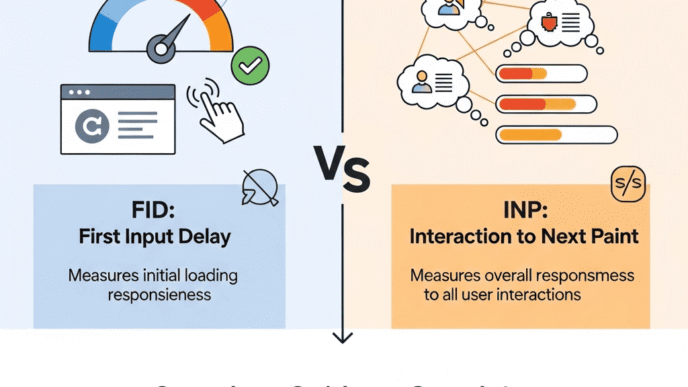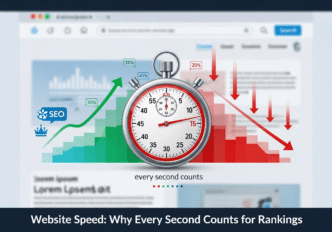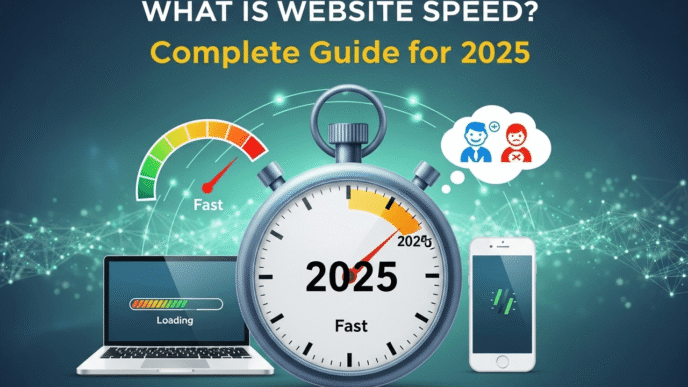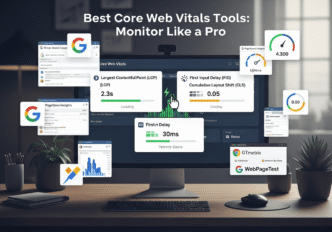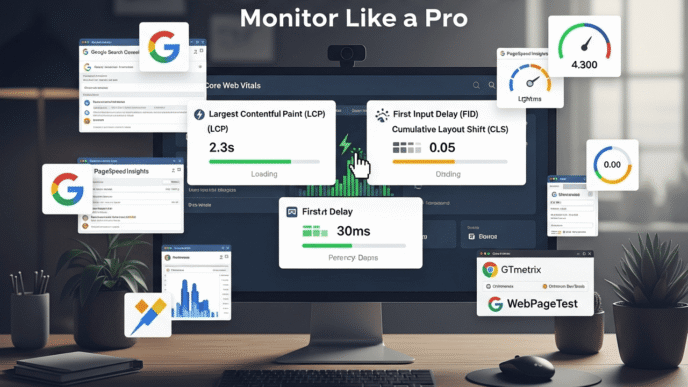LCP Optimization: Boost Your Site Speed in 2025
Ever clicked on a website and waited… and waited… and waited for the main content to show up? Yeah, that awkward moment when you’re staring at a blank screen wondering if your internet died. Well, congratulations – you’ve just experienced a terrible LCP optimization nightmare!
Largest Contentful Paint (LCP) is basically Google’s way of measuring how fast your website’s main content appears. Think of it as the digital equivalent of a first impression – and we all know you only get one shot at that.
In this guide, we’ll dive deep into everything you need to know about LCP optimization, from understanding what slows down your page loading speed to implementing proven techniques that’ll make your site lightning-fast. Ready to turn your website from a digital sloth into a speed demon?
Table of Contents
Toggle
What Exactly Is LCP and Why Should You Care?
Largest Contentful Paint measures the time it takes for the largest visible element on your webpage to fully load. This could be a hero image, a video, or a large block of text – basically whatever takes up the most real estate above the fold.
Google introduced LCP as part of their Core Web Vitals metrics because they realized that users don’t care about technical loading metrics. They care about one simple question: “When can I actually see and use this content?”
Here’s what Google considers good LCP scores:
- Good: 2.5 seconds or less
- Needs Improvement: 2.5 to 4.0 seconds
- Poor: More than 4.0 seconds
Pro Tip: If your LCP is over 4 seconds, users are probably already hitting the back button. Studies show that 53% of mobile users abandon sites that take longer than 3 seconds to load.
How Do I Check My Current LCP Performance?
Before you can improve LCP scores, you need to know where you stand. Here are the best tools for conducting a website speed audit:
| Tool | Best For | LCP Measurement | Free/Paid |
|---|---|---|---|
| Google PageSpeed Insights | Quick overview | Lab + Field data | Free |
| Chrome DevTools | Deep debugging | Lab data only | Free |
| GTmetrix | Detailed analysis | Lab + Field data | Free/Premium |
| WebPageTest | Advanced testing | Lab data | Free |
| Google Search Console | Real user data | Field data only | Free |
Chrome DevTools is my personal favorite for debugging because it shows you exactly which element is your LCP candidate. Just press F12, go to the Lighthouse tab, and run a performance audit.
What’s Actually Slowing Down Your LCP?
Understanding the common culprits behind slow LCP loading times is half the battle. Let me break down the main villains:
Server Response Time Issues
Your server is like a restaurant kitchen – if it’s slow to start cooking, everything else gets delayed. A server response time over 200ms can seriously hurt your loading performance.
Render-Blocking Resources
CSS and JavaScript files that block rendering are like that one person who holds up the elevator for everyone. They prevent your content from appearing until they’re fully processed.
Large Images and Media Files
Unoptimized images are the #1 LCP killer. A 5MB hero image might look stunning, but it’s also stunning your users into leaving.
Web Fonts Loading Slowly
Custom fonts can cause invisible text (FOIT) or unstyled text flashes (FOUT), both of which hurt user experience and LCP scores.
How to Improve LCP Scores: The Ultimate Techniques
Now for the good stuff – let’s talk largest contentful paint optimization techniques that actually work:
1. Optimize Your Images Like a Pro
Images are usually the LCP element, so this is where you’ll get the biggest bang for your buck:
- Use modern formats: WebP or AVIF instead of JPEG/PNG
- Implement responsive images: Serve different sizes for different devices
- Add proper sizing attributes: Include width and height to prevent layout shifts
- Lazy load non-critical images: But NOT your LCP image!
Pro Tip: Never lazy load your LCP image – it defeats the purpose of fast loading. Use loading="eager" or omit the loading attribute entirely for above-the-fold content.
2. Supercharge Your Server Response Time
A fast server is the foundation of good web performance metrics:
- Upgrade your hosting: Shared hosting is cheap but often slow
- Use a CDN: Content Delivery Networks serve files from locations closer to users
- Enable compression: Gzip or Brotli can reduce file sizes by 70%+
- Optimize your database: Clean up unused plugins and data
Real-world example: An e-commerce client improved their LCP from 4.2s to 1.8s just by switching from shared hosting to a managed WordPress host with SSD storage.
3. Eliminate Render-Blocking Resources
These are the traffic jams of web performance:
- Inline critical CSS: Put essential styles directly in the HTML
- Defer non-critical JavaScript: Use
deferorasyncattributes - Minimize CSS/JS files: Remove unused code and compress files
- Use resource hints:
preload,prefetch, andpreconnectstrategically
4. Implement Smart Font Loading Strategies
Fonts can make or break your LCP performance best practices:
- Use font-display: swap: Shows fallback fonts while custom fonts load
- Preload critical fonts: Use
<link rel="preload">for important typefaces - Subset your fonts: Only include characters you actually use
- Consider system fonts: They load instantly since they’re already on the device
| Font Loading Strategy | LCP Impact | Implementation Difficulty |
|---|---|---|
| System Fonts | Excellent | Easy |
| Google Fonts with display=swap | Good | Easy |
| Self-hosted with preload | Very Good | Medium |
| Variable Fonts | Good | Medium-Hard |
Advanced LCP Optimization Strategies
Ready to take your site speed optimization to the next level? Here are some advanced techniques:
Server-Side Rendering (SSR)
Instead of loading a blank page and building it with JavaScript, SSR delivers fully-formed HTML immediately. It’s like getting a finished meal instead of ingredients and a recipe.
Critical Resource Prioritization
Use fetchpriority="high" on your LCP image to tell the browser “this is important, load it first!”
Image Optimization Automation
Tools like Cloudinary or ImageOptim can automatically optimize images based on the user’s device and connection speed.
Real-World Case Study: From 5.2s to 1.9s LCP
Let me share a recent success story that perfectly illustrates these improve largest contentful paint metrics techniques in action:
The Challenge: A photography portfolio site with an LCP of 5.2 seconds The Problems:
- 8MB unoptimized hero images
- Render-blocking CSS for 12 different font families
- Slow shared hosting with no compression
The Solution:
- Converted images to WebP format (reduced size by 85%)
- Implemented critical CSS inlining
- Reduced fonts to 2 families with font-display: swap
- Moved to a faster host with CDN
The Result: LCP dropped to 1.9 seconds, bounce rate decreased by 40%, and organic traffic increased by 60% within 3 months.
Quick Wins for Immediate LCP Improvements
Want some fast results? Here’s your how to improve LCP scores quick-start checklist:
- Compress your images using TinyPNG or similar tools
- Enable browser caching through your hosting provider
- Minify your CSS and JavaScript using online tools
- Remove unused plugins and themes from WordPress
- Choose a faster hosting provider if yours is consistently slow
Pro Tip: Start with image optimization – it’s the easiest win and often provides the biggest improvement. You can literally see results in minutes.
Tools and Plugins for Ongoing LCP Monitoring
Core web vitals improvement isn’t a one-and-done deal. You need to monitor continuously:
For WordPress Users:
- WP Rocket: Comprehensive caching and optimization
- Smush: Image compression and optimization
- Autoptimize: CSS/JS minification and optimization
For General Monitoring:
- Google Search Console: Real user data from your actual visitors
- New Relic: Advanced performance monitoring
- Pingdom: Uptime and speed monitoring
Common LCP Optimization Mistakes to Avoid
Learn from others’ mistakes – here’s what NOT to do:
- Don’t lazy load your LCP image (I can’t stress this enough!)
- Don’t ignore mobile performance – most traffic is mobile now
- Don’t over-optimize – sometimes perfect is the enemy of good
- Don’t forget to test changes – what works on one site might not work on another
The Future of LCP and Web Performance
As we move through 2025, web performance metrics continue evolving. Google is pushing for even faster experiences, and users’ patience is getting shorter.
The key is to think of LCP optimization not as a technical checkbox, but as a user experience priority. Fast sites don’t just rank better – they convert better, retain users longer, and provide genuine value.
Want to dive deeper into the complete picture of Core Web Vitals and their impact on SEO? Understanding how LCP fits into the broader performance ecosystem is crucial for long-term success.
Wrapping Up: Your LCP Optimization Action Plan
Here’s your step-by-step action plan to fix slow LCP loading times:
- Audit your current performance using PageSpeed Insights
- Identify your LCP element using Chrome DevTools
- Start with image optimization for quick wins
- Address server and hosting issues for foundation improvements
- Implement advanced techniques based on your specific needs
- Monitor and iterate using the tools mentioned above
Remember, LCP optimization is a journey, not a destination. Technology changes, user expectations evolve, and your content grows. The key is building performance consciousness into your workflow from day one.
Your users will thank you, Google will reward you, and your conversion rates will definitely appreciate the effort. Now stop reading and start optimizing – your website’s need for speed awaits!
Have questions about implementing these LCP optimization techniques? Drop them in the comments below, and let’s solve them together!

